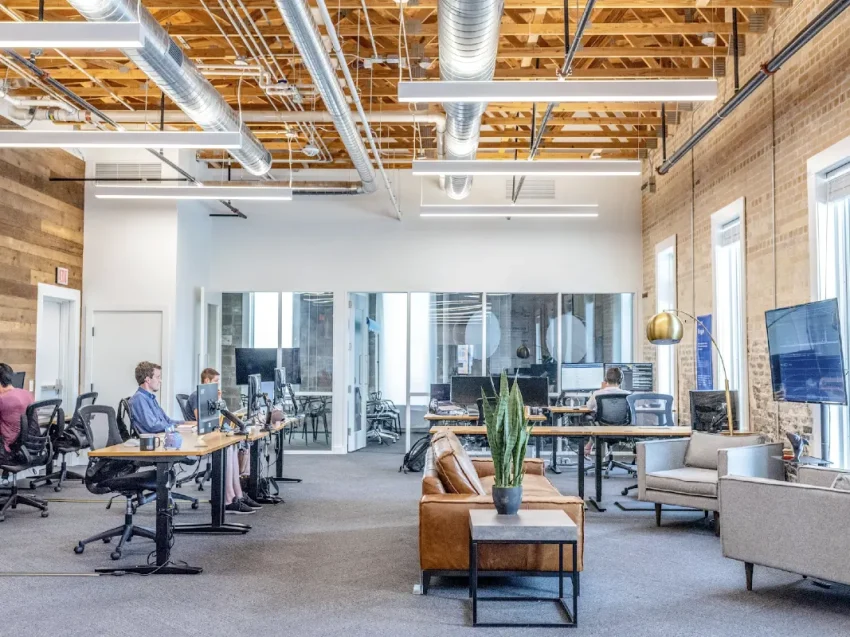A Guide to Finding Workspaces That Inspire Innovation For Your Small Team

The physical environment where your team works has a profound influence on creativity, communication, and overall productivity. When you’re leading a small team, every detail matters. A space that is flexible, stimulating, and well-aligned with your company culture can become a catalyst for innovation and growth.
Finding the right workspace is more than a logistical task. It involves understanding your team’s needs and choosing a location that encourages energy and creativity while supporting collaboration.
This guide offers practical tips for selecting a work environment where your small team can thrive.
Contents
Understand Your Team’s Work Habits
Before touring spaces or comparing pricing models, take a moment to assess how your team works. Do they need quiet areas for deep concentration? Are they often brainstorming ideas as a group? Are they hybrid or in-office full-time?
Some teams operate best in open-concept layouts that promote movement and conversation. Others benefit from designated workstations with sound privacy. There is no one-size-fits-all answer. What matters is choosing a setup that complements your workflows.
Think through your team’s daily routines, technology needs, and communication patterns. Understanding this will help narrow down workspace features that truly matter.
Prioritize Natural Light and Open Design
Workspaces with plenty of natural light contribute to improved energy levels and mental clarity. Studies suggest that exposure to sunlight during the workday enhances focus and mood. That boost in mental well-being is directly tied to creative thinking and problem-solving, both of which are critical to innovative work.
Look for layouts that feel open rather than boxed in. Even in smaller offices, design elements like glass dividers or high ceilings can make a big difference in how spacious and energizing the environment feels. Comfortable seating, good ventilation, and access to windows create a foundation for long-term team satisfaction.
Look Beyond the Desk
Innovation happens in unexpected places. Breakout rooms, communal kitchens, rooftop lounges, and casual nooks give team members the space to recharge or spark impromptu conversations that lead to fresh ideas. These moments of informal interaction are often where innovation begins.
A workspace that includes quiet corners or shared areas promotes a balance between focused tasks and dynamic teamwork. The more variety you build into your environment, the more chances you give your team to think differently and connect across roles. While desks and meeting rooms are necessary, they shouldn’t be the only consideration.
Seek Out Flexible Lease Terms
Small teams often go through rapid growth or change. Choosing a space that allows for scalability is a smart move. Shorter leases, shared offices, or coworking hubs let you test the fit of a space without locking into a long-term commitment.
Flexibility also means being able to rearrange furniture, repurpose rooms, or shift from one setup to another as your business evolves. This adaptability can be just as important as square footage or location. When touring workspaces, ask about modification options and whether the space is designed with startups or small teams in mind.
Location Matters for Energy and Culture
The neighborhood around your workspace sets the tone for daily routines and company culture. A lively area with coffee shops, green spaces, and walkable streets can inject positive energy into your team’s day. Proximity to transit makes commuting easier and can widen your hiring pool.
Certain locations naturally foster a sense of connection. Creative industries may gravitate toward art districts or warehouse-style studios, while tech teams might prefer modern, minimalist hubs near innovation corridors. One example of a space designed with this energy in mind is Northwest Work Lofts, which blends architectural character with a sense of community. The space inspires productivity without feeling corporate or confining. Teams that settle into dynamic locations like this often find it easier to attract talent and build culture.
Consider what the surrounding area contributes to your brand and your team’s mindset.
Pay Attention to Acoustics and Privacy
Distractions can derail innovation quickly. Even in vibrant environments, acoustic design plays a key role in how well people can focus or conduct meetings. Look for spaces that include quiet rooms, call booths, or acoustic panels to absorb noise.
If your team handles sensitive information or frequently joins video calls, having reliable access to private meeting spaces is non-negotiable.
Workspaces that balance openness with sound control allow your team to think clearly and communicate without interruption. This is particularly important for roles that require long stretches of uninterrupted concentration.
Ask About Community and Events
Shared office environments and loft-style workspaces often include networking events, learning sessions, or wellness programming. These extras support connection and development, which can spark ideas your team might not encounter in isolation.
Even if you’re leasing a private office, being part of a larger work community can offer valuable exposure and informal collaboration. Many teams find inspiration just by interacting with professionals from other industries nearby.
Ask if the workspace hosts regular events or provides opportunities for tenants to connect. These touchpoints can contribute to a more engaged and inspired team environment.
The right workspace does more than hold desks and chairs. It encourages creativity, supports collaboration, and aligns with your team’s values and work style. Whether you’re in growth mode or looking for your first dedicated office, the environment you choose will shape the way your team solves problems and generates ideas.
By focusing on factors like flexibility, design, location, and community, you can find a space that inspires daily progress. In doing so, your team will be more equipped to innovate, adapt, and thrive together.



